Mick Kirkbride is known to many not only for his paintings but also for his teaching work with educational institutions including the RA and RADA. With a new exhibition opening this month in Hampstead, we were delighted that Mick found time to tell us about his formative years, influences and painting practice . . .
EARLY DAYS
"I was very much of the Tony Hart – ‘Vision On’ generation. It was his witty and playful manipulation of materials that excited my thinking and ignited something inside me. This something would eventually form a career path within the visual arts.
I was lucky enough to have an inspirational art teacher at school who encouraged me to apply to Art College. Although I didn't have the required academic qualifications, I managed to gain a place on the Foundation Course at Sunderland Polytechnic, and the journey had begun for a very intimidated and naïve seventeen-year-old from the pitmatic outback of County Durham.
I somehow managed to scramble my way onto the degree course and was determined to be a landscape painter. I was obsessed with the paintings of Constable, Turner, and Gainsborough, but also spent many hours working directly from the model. This developed my perceptual and technical skills, and gave me the confidence to make work which had its roots in the visible world. I became focused on recording things that were important and familiar to me.
The rather grainy image below was the first serious painting I sold from my degree show in 1980 - the demolition of miner's cottages in Shotton Colliery, County Durham. Many of my family were from a mining background, and this was the landscape of my youth.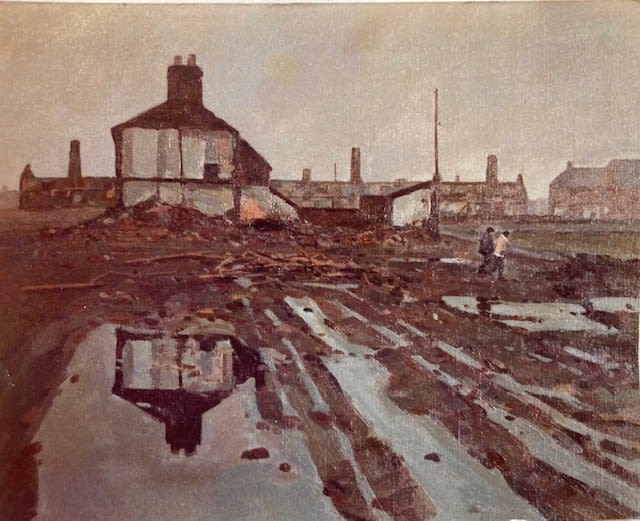
'Demolition' (oil on canvas, 76 x 90cm)
Searching For an identity
In the 1980s, Newcastle upon Tyne had a very buoyant and flourishing art scene with many studio groups. The studio I joined was filled with well-established artists and educators, many of whom taught Fine Art at the University and what was then Newcastle Polytechnic.
Initially, I felt very much the interloper, but slowly began to absorb their knowledge, feed off their experience, and grow from their encouragement. I began to realise that art was as much about ideas and content, and skill should do something other than display itself, going beyond a mere simulacrum. My response to this was to embark on a series of paintings about Football hooligans. These issue-based works which utilised caricatural images drawn from contemporary events, ridiculed and condemned a particular mentality which had attached itself to the beautiful game.
Rubens and Gericault became influences - largely due to the scale and physicality of the subject I was dealing with. By the mid-80s there appeared to be a resurgence in figurative painting with the emergence of The Glasgow Boys - Peter Howson, Steven Campbell, and Ken Currie amongst others, all of whom became influences. Jörg Immendorff's 'Café Deutschland' series made a huge impact upon me, as did Sandro Chia's Neo-Expressionist handling of paint.
I was lucky enough to receive public funding from Northern Arts to augment the series, culminating in a major travel award to attend the 1990 FIFA World Cup finals in Italy. The image below is in many ways the culmination of the series, a parodic version of Gericault's 'Raft of the Medusa', and was typical of the scale and ambition of my work at that time. It features England fans set adrift on a raft after having run amok on the 'Tor Britannia' ferry on its way to Sweden for a "European Football Championship" qualifier.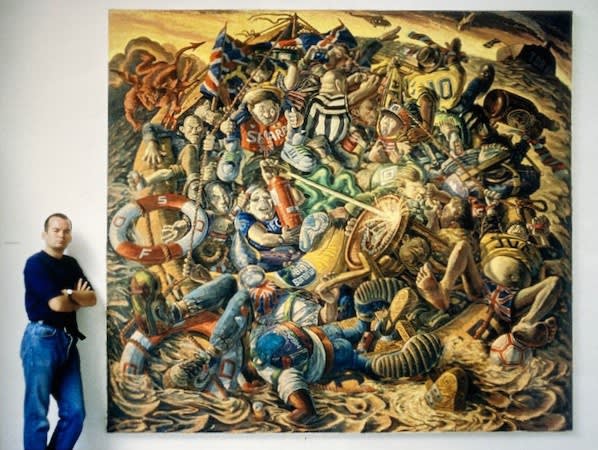
'The Raft of the Tor Britannia' (1991, oil on canvas)
Further Study
There is something familiar about the age-old narrative of northern artists succumbing to the lure of London. There was a sense of incompletion in my art education, and in 1991, I gained a place at the Royal Academy Schools. This was not a paradigm of art education but a unique experience in an equally unique environment. It offered a year to unlearn and question both direction and process, a year to experiment, and a year to put things back together again. A personal recollection perhaps, but I'm sure many of my fellow students would concur.
The RA Schools wasn't a cerebral course, certainly not in the Goldsmiths sense, but it did give you the machinery to make paintings. I began experimenting with egg tempera and distemper techniques, although the sardonic edge in terms of subject matter remained. The image below is from my final show at the RA and features an ironic pastiche of a Donald McGill saucy postcard set within a design emporium.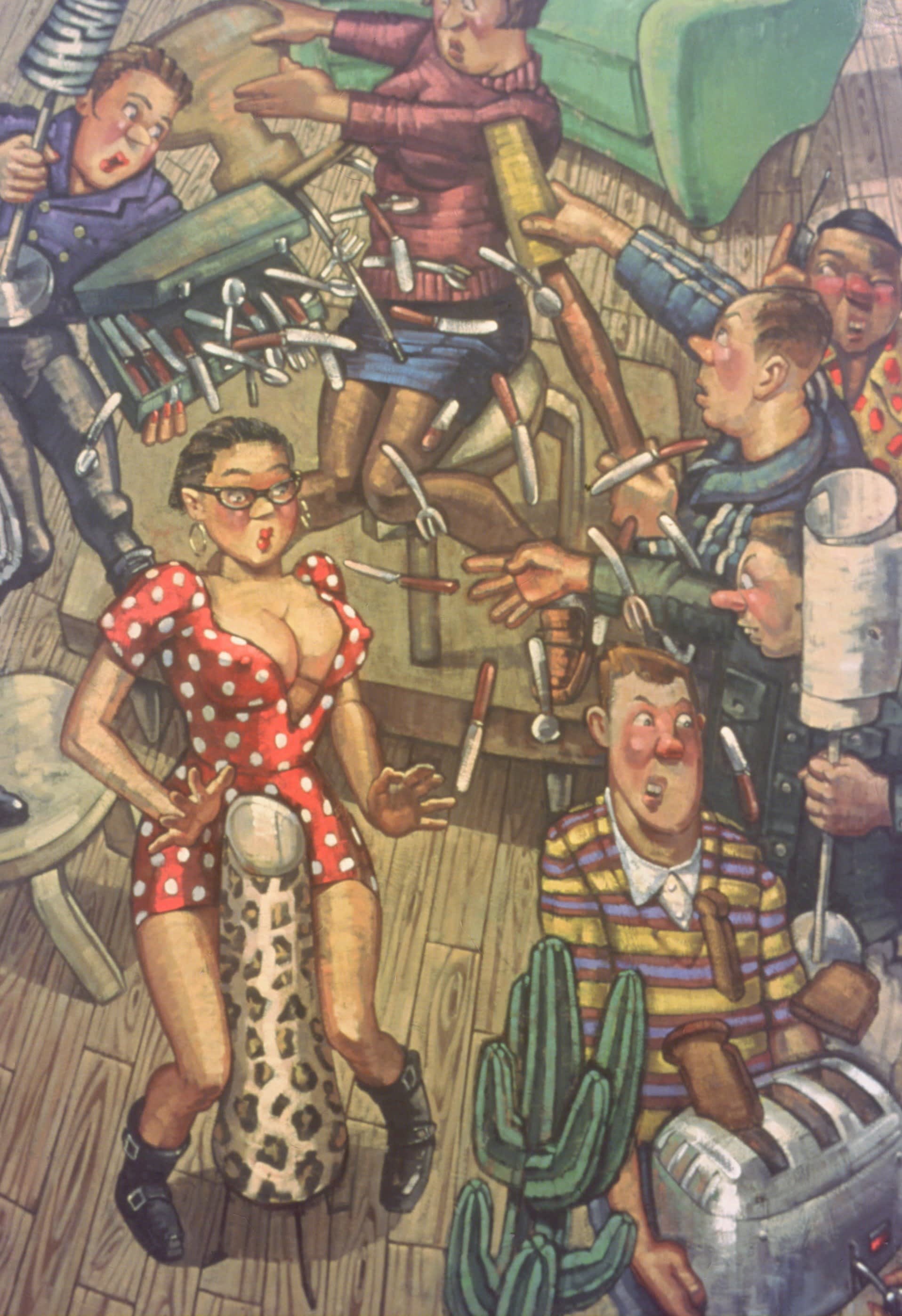
'Carry on Conran' (oil on canvas, 213 x 120cm)
Establishing a support system
I sell paintings fitfully, and have quickly learned that although we have a right to our labour, we don't have a right to the fruits of our labour. Luckily, I have been able to support my painting practice through regular teaching ever since graduating in 1980, having taught at all levels including postgraduate. The most influential period being my time as Senior Lecturer in 'Visual Studies' at the London College of Fashion. This was invaluable in terms of gaining deeper pedagogical insight, developing critical language, and having a broader appreciation of the visual domain.
Currently, I teach workshops and Friends' Life Drawing at the RA. I also teach drawing to a variety of undergraduate specialisms at RADA (Royal Academy of Dramatic Art), and at smaller independent London art schools such as Hampstead and Insight Schools of Art. My time as curator of the NEAC Education Programme was particularly rewarding and memorable. Teaching weekly Life Drawing sessions and mentoring scholars created a sense of being at the very heartbeat of the New English.
Teaching has proved to be a very edifying and reliable support system. It affords complete artistic freedom in terms of direction, language and subject, for without this I see very little point in being an artist.
Painting PracticE
Influences on my work have been wide-ranging and too numerous to mention, from 16th Century Italian Commedia Dell'Arte Theatre to Neo Rauch. There are however certain artists who have remained a constant inspiration such as William Hogarth, Walter Sickert, Edward Burra, and Stanley Spencer. Skewered satire, finding poetry in the quotidian, and compositional dexterity, are some of the elements I take from these artists and try to incorporate within my own work, with varying degrees of success.
The three images below are a manifestation of this . . .
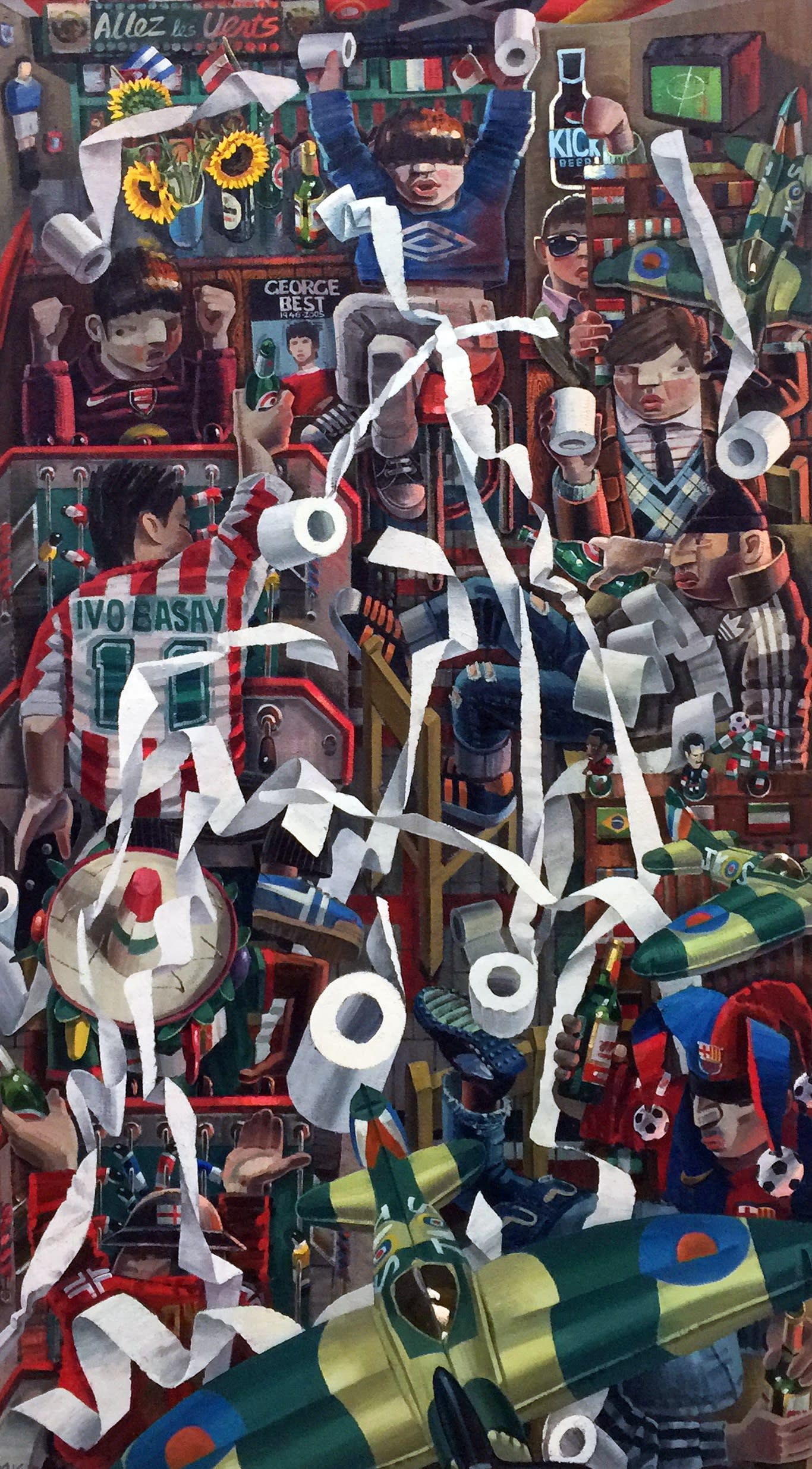
'Bar Kick' (oil on canvas, 220 x 140 cm)
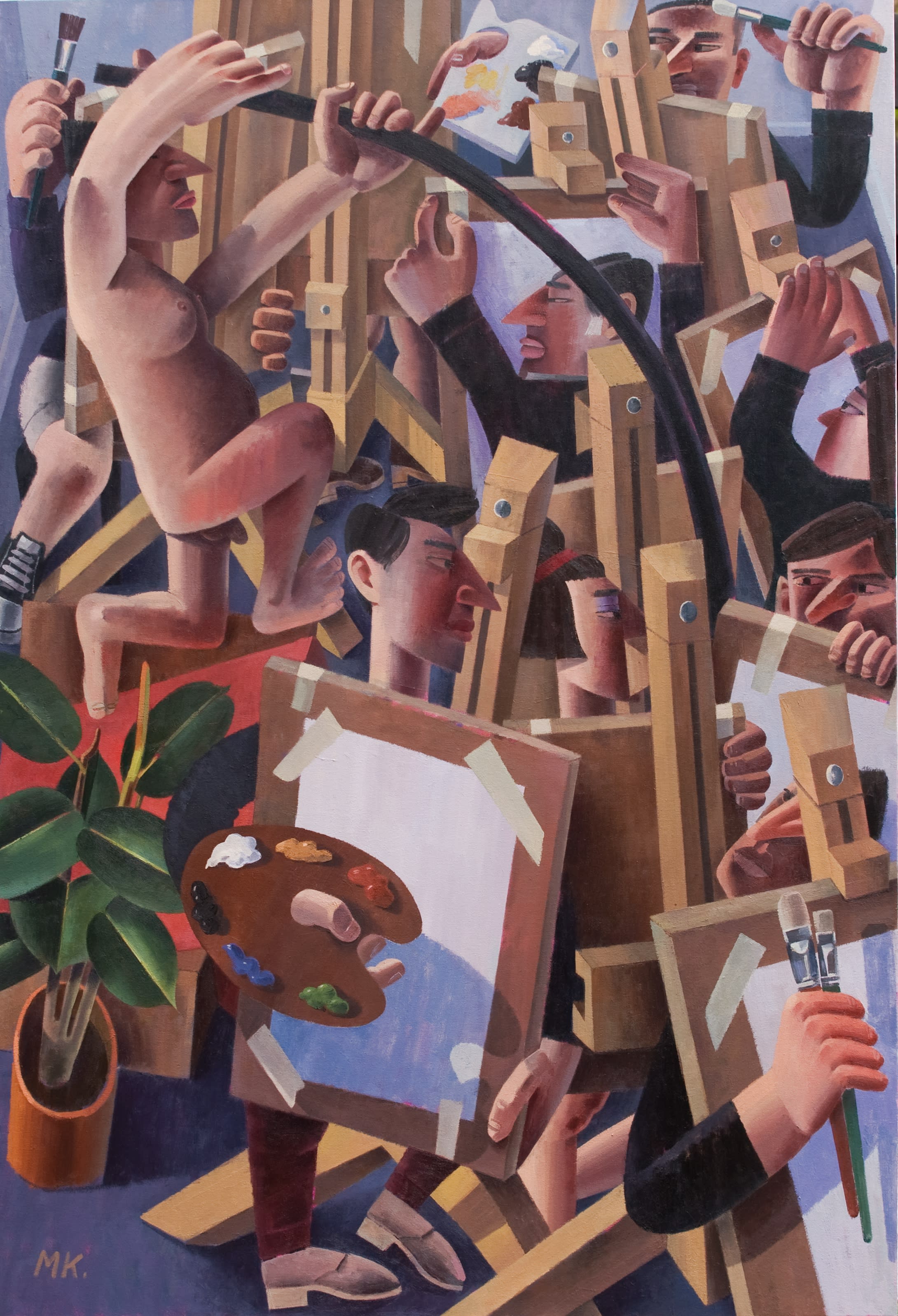
'Pandemonium at Putney' (oil on canvas, 150 x120cm)
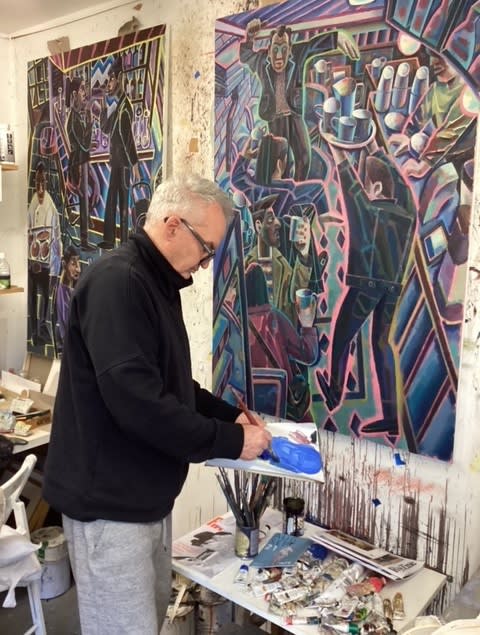
In the studio with 'The India Club' & 'The Attendant' (both oil on canvas)
The human figure is always the dominant structural motif within my work. I am interested in where human beings have been, and what they have done to a place. This could be an observed situation, something remembered, or something conjured. Sometimes the paintings are pure supposition, sometimes celebratory, and sometimes they question and confront.
They all begin with fragments of observational drawing and notational sketches, which accrue and then amalgamate into a cohesive pictorial narrative. I like to create fictive space - painterly dioramas into which I drop figures doing ambivalent things, very much like actors on a stage.
As an antidote to all the technical abracadabra of studio endeavour, I have for many years painted 'en plein air' watercolours. The joy of it all, and the challenge of developing a visual shorthand to pin down the ephemerality of each encounter create the excitement. Partly travelogue and partly diaristic these works have become symbolic of time and place in which many personal memories and nuances are held.
Auerbach once said, "If you didn't think the next work was going to be better than the last - you wouldn't carry on". As artists, I think this is what drives us all forward."
Mick Kirkbride
Mick's exhibition 'Home and Away' is at the Peggy Jay Gallery at Burgh House in London from the 20th to 31st July. Find out more.
Find out more about Mick and his forthcoming classes, and view a selection of his work on his NEAC artist profile page.


